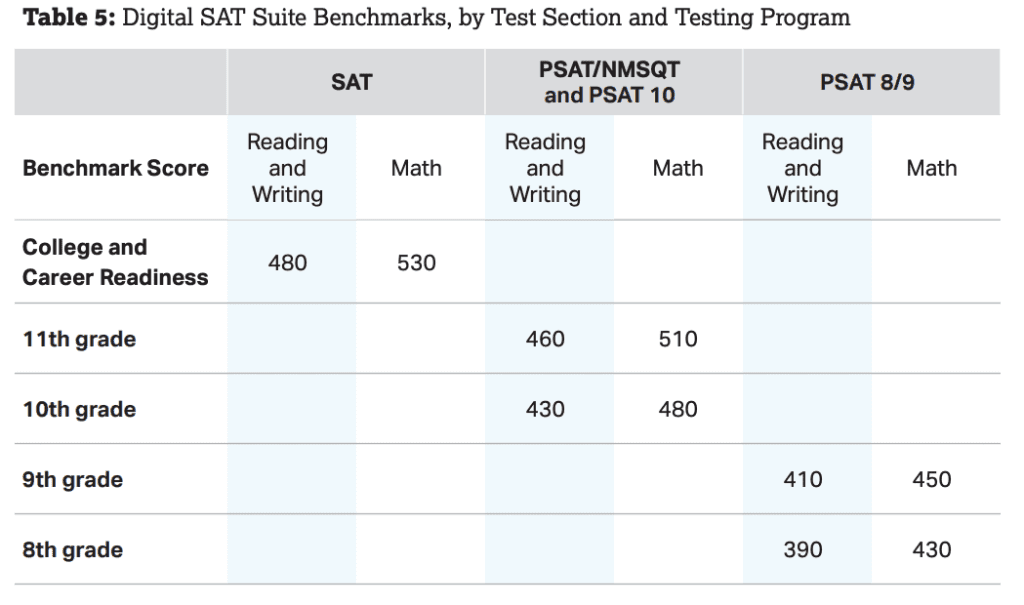
The digital SAT, short for the digital Scholastic Assessment Test or “dSAT”, is a standardized test taken by high school students in the United States or internationally. This test is often a requirement for college entrance applications and was traditionally administered in a pen and paper format. However, the SAT has transitioned to a digital format in response to advancements in technology and changes in educational testing.
Many colleges and universities require SAT (and therefore dSAT) scores as part of their admissions process, using them to assess an applicant’s academic readiness and potential. A strong SAT score can increase a student’s chances of acceptance into their desired institutions and potentially qualify them for scholarships or other forms of financial aid.
In this article, we will cover what is the dSAT, what’s difference between dSAT and regular SAT and what changed in the content, the difficulty levels, scoring, and why the change was made.

The digital SAT brings multiple changes, notably a shorter duration, changes to the content, and a revised structure. Unlike its paper-and-pencil predecessor, which lasted over three hours and had 154 questions, the digital version clocks in at just over two hours with 98 questions. It consolidates the reading and writing sections into one section (now called Reading & Writing), which is taken alongside the Math section. Despite these changes, the scoring system remains the same, ranging from 200 to 800 points per section, or 400 to 1,600 points total. And the test is still administered by proctors at designated testing centers, with accommodations available including a paper test option.
The digital SAT brings some fresh changes to the content. Now, the reading passages are shorter, usually just a paragraph long, and cover various topics like poetry. Although you’ll still find familiar question types about main ideas and grammar, there are also new question formats to tackle. One interesting addition is that students have to piece together conclusions from made-up student notes, which challenges their critical thinking skills. These updates aim to make the SAT more up-to-date while keeping its standards high.
The Reading and Writing Section of the SAT includes questions from four content domains: Craft and Structure, Information and Ideas, Standard English Conventions, and Expression of Ideas. These domains cover various skills such as comprehension, analysis, and editing, aiming to evaluate a student’s ability to understand and use language effectively. Questions within each domain are strategically grouped to aid students in managing their time efficiently and showcasing their knowledge and skills effectively during the test.
Content Domain | Testing Points | Questions |
|---|---|---|
Craft and Structure | Words in context Text structure and purpose Cross-text connections | 13-15 questions (28%) |
Information and Ideas | Central ideas and details Command of evidence Inferences | 12-14 questions (26%) |
Standard English Conventions | Boundaries form, structure, and sense | 11-15 questions (26%) |
Expression of Ideas | Rhetorical synthesis Transitions | 8-12 questions (20%) |
The Math section of the digital SAT assessments is tailored to evaluate students’ mastery of critical math concepts essential for college and career readiness. This section focuses on algebra, advanced math, problem-solving, data analysis, and geometry, this section aims to assess student’s understanding, and application of mathematical concepts through multiple-choice and student-produced response questions.
Content Domain | Testing Points | Question Distribution |
|---|---|---|
Algebra | Linear equations in one variable Linear equations in two variables Linear functions Systems of two linear equations in two variables Linear inequalities in one or two variables | 13-15 questions (35%) |
Advanced Math | Equivalent expressions Nonlinear equations in one variable and systems of equations in two variables Nonlinear functions | 13-15 questions (35%) |
Problem-Solving and Data Analysis | Ratios, rates, proportional relationships, and units Percentages One-variable data: distributions and measures of center and spread | 5–7 questions (15%) |
Geometry and Trigonometry | Area and volume Lines, angles, and triangles Right triangles and trigonometry | 5–7 questions (15%) |
Adaptive test and other digital features
The digital SAT introduces multi-stage adaptive testing, which tailors the test’s difficulty based on a student’s performance. Each segment (Reading & Writing, and Math) comprises two modules, and the difficulty of the second module will adjust according to the student’s performance in the first module. This personalized approach offers a more tailored testing experience, making the test easier if students are struggling, or harder if students are crushing it. Your final score will incorporate this difficulty adjustment, so students aiming for higher scores should prepare for the harder second section.
Additionally, the digital SAT incorporates features aimed at making the test-taking process easier. Students can flag questions for later review, which gives them the ability to strategically skip questions they don’t know to return to them later. Additionally, a countdown clock alerts students when time is running low, giving them the option to display or hide it on their testing screen.
Shorter test
The digital SAT is also notably shorter, with a duration of 2 hours and 14 minutes compared to the previous 3-hour sessions. This change was made to streamline the testing process and alleviate some of the stress associated with lengthy exams. Additionally, test-takers now have more time to answer each question, emphasizing their skills and knowledge rather than test-taking speed. This shift encourages deeper understanding and critical thinking, ultimately providing a more accurate measure of students’ capabilities.
Content changes
The content of the SAT also underwent some minor but important changes in the transition to the digital SAT:
These changes are not meant to dramatically change the difficulty of the SAT, but most agree that they should each make the test a little bit easier.
Improved score reports
Students now have the advantage of receiving their scores within days instead of waiting weeks, as was the case with the SAT. This expedited score reporting system ensures that students receive their results quickly and can get feedback sooner and make better decisions.
Another notable change is the inclusion of information and resources about local two-year colleges, workforce training programs, and career options in the digital SAT Suite score reports. This feature aims to connect students with post-secondary opportunities and guide them in their educational and career pathways.
Better logistics
Additionally, the digital format enhances test security by providing each student with a unique test form, minimizing the risk of answer sharing in case of compromise. Lastly, states, schools, and districts now have increased flexibility in administering SAT Suite tests, allowing for more convenient and adaptable testing schedules and logistics.

Opinions on the difficulty of the digital SAT vary among test-takers and educators, but many perceive it to be slightly easier compared to its paper-based predecessor.
One notable feature contributing to this perception is the allowance of calculators throughout the entire Math section. Unlike the former SAT, which divided the math section into portions where calculators were permitted and not permitted, the digital SAT simplifies this by allowing calculators to be used throughout a single math section. Moreover, the test provides access to Desmos, a built-in graphing calculator, eliminating the need for students to bring their own calculators and providing a powerful tool that can outright solve some dSAT problems. These changes may alleviate some of the mathematical challenges students faced in the past, which contributes to the perception of the digital SAT being easier. However, individual experiences and perspectives on test difficulty may vary, especially if people are not familiar with using calculators on computers.
The other major content change that some believe makes the digital SAT easier is the change to reading comprehension problems. Previously, on the paper SAT, students had to read a single large passage and answer 2-5 questions about that passage, often going back and referencing the passage multiple times throughout the process. The digital SAT changed this format and now has one shorter passage per question. This removes one of the trickier and more difficult problem types in the Reading & Writing section and replaces it with a simpler version, which many believe is easier for students to handle. This change is especially important for those who struggle with the English language.
While the digital SAT may be perceived as easier, it still presents a formidable challenge. The SAT aims to evaluate students’ critical thinking, problem-solving, and analytical abilities across diverse subject areas. Moreover, the scoring process employs equating rather than curving, ensuring that scores from different test dates are comparable. This practice safeguards the test’s reliability and validity by maintaining consistency in score interpretation. Therefore, despite certain conveniences offered by the digital SAT, its overall difficulty level and equitable scoring mechanisms underscore its role as a rigorous assessment of students’ academic aptitude.
The digital SAT is scored on a scale of 400-1600, with 400 being the minimum and 1600 as the maximum. Each digital SAT assessment provides students with three distinct scores: a total score and two section scores. The total score represents students’ overall performance across the entire assessment and is calculated as the sum of the two section scores. These section scores are specifically for Reading and Writing, and Math, reflecting students’ achievements in each respective area. These tests use a scale to measure scores, ranging from a minimum to a maximum. This scale helps students and educators track progress over time. For example, on the PSAT 8/9, scores range from 240 to 1440, with 10-point intervals.
Benchmarks are used to understand what scores mean. They show the score needed to be considered ready for college and careers and help track progress over the years. The score report is more than just numbers. It shows improvement from test to test, identifies subjects to focus on, and provides links to practice resources. It also compares scores to others’ and tracks progress toward college readiness. The report also indicates if a student qualifies for the National Merit Scholarship and connects them with resources for college planning and scholarships.

Over the years, the SAT has undergone several changes driven by the College Board’s commitment to improving the test’s accessibility, relevance, and environmental impact. Transitioning the SAT to a digital format aims to make the SAT easier to administer and more accommodating for students. The digital format also allows for the adaptive testing experience, which is more accommodating for students of different academic levels. This move also aligns with efforts to reduce environmental footprint by reducing the waste of paper test and paper grading.
And of course, the SAT test is a business, and the test has to constantly prove its worth compared to the ACT (and new CLT) to parents, students, and college administrators alike. The shorter format is a big hit with students already, and they love being able to use a calculator in all sections. College administrators also seem to be fans of how the adaptive testing format can provide more accurate evaluation.
We hope that this information has provided clarity on any inquiries you may have had regarding the digital SAT. As you embark on your test prep journey, remember to devise a strategic study plan, make use of reliable study materials, and tap into available support networks like instructors or online communities. Make sure to check out our complete guide to the SAT post for more details on the SAT. Stay committed, stay focused, and have confidence in your readiness. Best of luck!